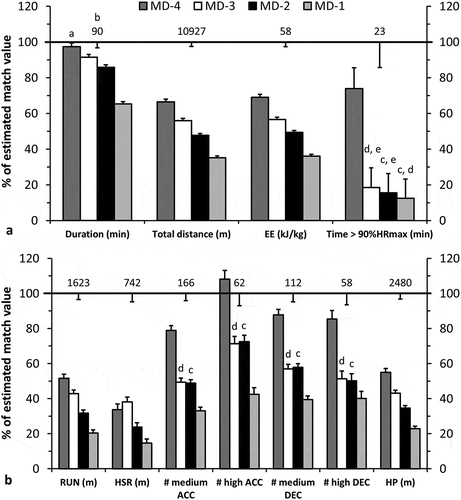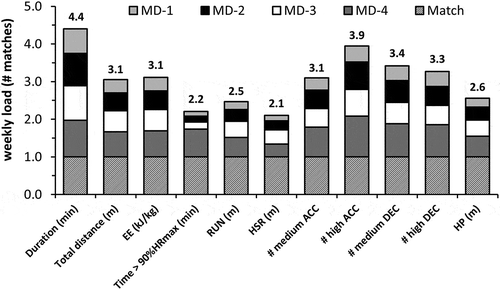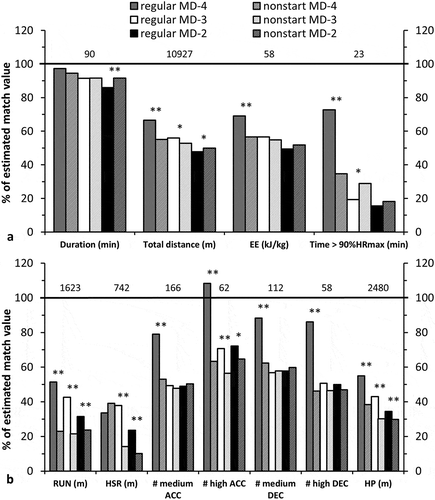Figures & data
Table 1. Descriptive statistics of training load variables of match, regular training, and nonstarters training (mean ± SD).
Figure 1. Estimated training load variables of typical training days expressed as a percentage of estimated match values.
Values above the horizontal line represent the estimated full match values for each variable (=100%); error bars of training days indicate 95% confidence interval of the mean difference between each estimated training day and estimated match, expressed as a relative match value. Error bars of the match indicate 95% confidence interval of the estimated match value, expressed as a relative match value.Abbreviations: MD-4 = training session 4 days before match day (MD); EE = estimated energy expenditure; HR = heart rate; RUN = running (14.4–19.8 km · h−1); HSR = high-speed running (>19.8 km · h−1); ACC = accelerations (medium: 1.5–3.0 m · s−2; high: >3.0 m · s−2); DEC = decelerations (medium: -1.5 to -3.0 m · s−2; high: <-3.0 m · s−2); HP = high power (>20 W · kg−1).Estimated match and training session means are different from each other unless indicated by: a = not different from match, b = not different from MD-4, c = not different from MD-3, d = not different from MD-2, e = not different from MD-1.

Figure 2. Cumulative weekly training load of a typical week with 1 match and 4 subsequent training sessions (MD-4, MD-3, MD-2 and MD-1) expressed as number of matches per variable.
A typical week with 1 match was considered to be a week with a recovery training (day after the match; not recorded), a day off, 4 subsequent training sessions (MD-4, MD-3, MD-2 and MD-1) and a match.Abbreviations: MD-4 = training session 4 days before match day (MD); EE = estimated energy expenditure; HR = heart rate; RUN = running (14.4–19.8 km · h−1); HSR = high-speed running (>19.8 km · h−1); ACC = accelerations (medium: 1.5–3.0 m · s−2; high: >3.0 m · s−2); DEC = decelerations (medium: -1.5 to -3.0 m · s−2; high: <-3.0 m · s−2); HP = high power (>20 W · kg−1).

Figure 3. Estimated training load variables of regular and nonstarters training days expressed as a percentage of estimated match values.
Values above the horizontal line represent the estimated full match values for each variable (=100%); note that the nonstarters MD-4 training also includes training sessions with more than 4 days to the next match.Abbreviations: Regular = regular training session; non-start = nonstarters training session 1 day after match day (MD); MD-4 = training session 4 days before MD; EE = estimated energy expenditure; HR = heart rate; RUN = running (14.4–19.8 km · h−1); HSR = high-speed running (>19.8 km · h−1); ACC = accelerations (medium: 1.5–3.0 m · s−2; high: >3.0 m · s−2); DEC = decelerations (medium: -1.5 to -3.0 m · s−2; high: <-3.0 m · s−2); HP = high power (>20 W · kg−1).Regular and nonstarters training are different from each other when indicated by * (P < 0.05) or ** (P < 0.001).

Figure 4. Cumulative weekly load for starters and nonstarters during a typical week with 1 match (A) and 2 matches (B) expressed as number of matches per variable.
A typical week with 1 match (A) was considered to be a week starting with a recovery training for the starters (not recorded) and a nonstarters training session for the nonstarters (MD+1), followed by a day off, 4 subsequent training sessions (MD-4, MD-3, MD-2 and MD-1) and a match (only for starters). A typical week with 2 matches (B) consisted of 2 recovery sessions (starters) or 2 MD+1 sessions (nonstarters), 2 MD‒1 sessions, 2 matches (only for starters) and a day off.
Abbreviations: Regular = regular training session; non-start = nonstarters training session 1 day after match day (MD); MD‒4 = training session 4 days before MD; EE = estimated energy expenditure; HR = heart rate; RUN = running (14.4‒19.8 km · h‒1); HSR = high‒speed running (>19.8 km · h‒1); ACC = accelerations (medium: 1.5‒3.0 m · s‒2; high: >3.0 m · s‒2); DEC = decelerations (medium: ‒1.5 to ‒3.0 m · s‒2; high: <‒3.0 m · s‒2); HP = high power (>20 W · kg‒1).

